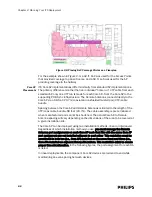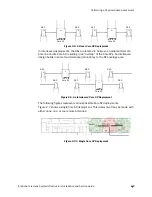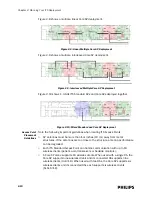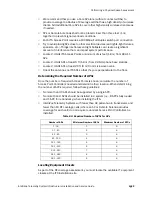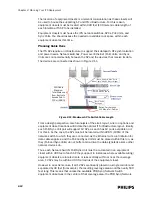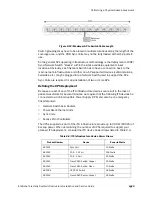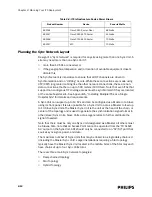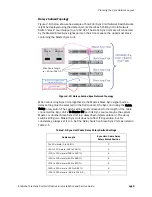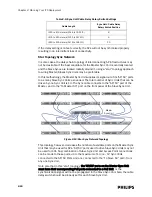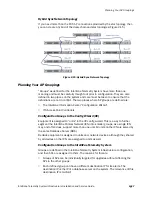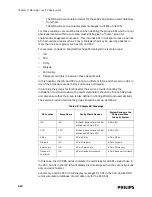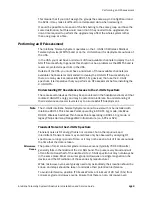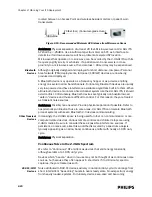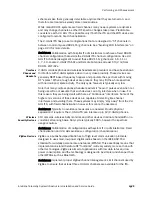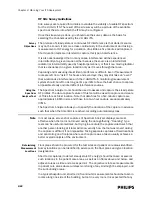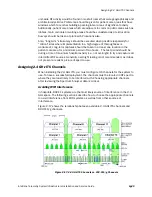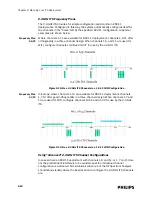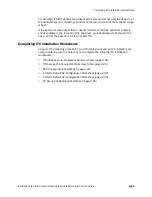
2-22
Chapter 2: Planning Your ITS Deployment
RF Site Survey Guidelines
Site surveys are required for all sites to validate the viability of usable RF spectrum
for the 2.4 GHz ITS. The result of the site survey will be a picture of the available
spectra at the site into which the ITS may be configured.
Once the site survey is done, you should use the survey data as the basis for
selecting the channels used by the 2.4 GHz ITS.
Survey
Objectives
The premise of steady-state or continuous RF interference is that while its source
may not be known, it is more or less continuously in the environment and taking a
measurement of RF energy for a duration of as little as five minutes will capture it.
Short duration tests are intended to capture this type of interference.
It is also acknowledged that in many cases, interference will be experienced
intermittently at a given location either because the source is an intermittent
radiator (or intermittently used by hospital personnel), or that it is a moving radiator
that is experienced in a given location only as it moves through that area.
Capturing and measuring intermittent interferers is difficult. Even if measurement
tools are left on to “listen” for hours and even days, they may still miss an “event”
that would cause interference with the 2.4GHz ITS. A monitoring/measurement
system should be left on as long as time permits to have the best chance to capture
all possible steady and intermittent interference sources.
Using the
Spectrum
Analyzer Tool
The Spectrum Analyzer tool should be used to assess and capture the steady-state
RF profiles. The data capture feature of this tool will be used to capture and create
.ccf files for each test location. Note that data files for a five-minute capture are
approximately 1.6Mb in size and those for a two-hour capture are approximately
37Mb.
The Spectrum Analyzer allows you to specify the duration of the capture in advance
such that when the time limit is reached, recording automatically stops.
Note
In most cases, screen shot captures of Spectrum Analyzer displays are most
effective when the tool is not moved during the data gathering. “Roaming” type
tests can be useful sometimes, but trying to annotate the captured data such that
another person looking at it later will know exactly how the tool was moved during
the capture is difficult, if not impossible. Taking separate captures at fixed locations
and annotating on a floorplan where each capture was a taken usually achieves a
better overall analysis of the environment.
Determining
Measurement
Locations
Floor plans should be procured for the test sites and patient care areas identified.
Survey locations can be identified in advance on the floor plans and given location
designations.
Short term captures (to detect steady state RF energy) should be taken at several
such locations in the patient care areas, as well as on floors above and below, and
adjacent areas as time and access permit. The objective is to take measurements
in patient care areas where wireless monitoring of any kind might be employed, and
the surrounding areas.
In a typical hospital unit, short term (five-minute) measurements should be taken in
rooms along one side of the building, but not in every room. It is expected that any
Summary of Contents for IntelliVue Telemetry System Infrastructure
Page 8: ...viii Contents ...
Page 14: ...xiv About This Guide ...
Page 100: ...3 22 Chapter 3 Installing and Configuring the ITS Figure 3 10 APC Filter Configuration Screen ...
Page 162: ...5 12 Chapter 5 Troubleshooting and Testing ...
Page 168: ...A 6 Chapter A Installing Multiple ITSs at a Single Hospital Site ...
Page 180: ...Index 8 Index ...

